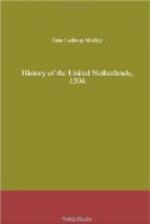Two very important cities still held for the King of Spain within the territories of what could now be fairly considered the United Dutch Republic—St. Gertruydenberg and Groningen.
Early in the spring of 1593, Maurice had completed his preparations for a siege, and on the 24th March appeared before Gertruydenberg.
It was a stately, ancient city, important for its wealth, its strength, and especially for its position. For without its possession even the province of Holland could hardly consider itself mistress of its own little domains. It was seated on the ancient Meuse, swollen as it approached the sea almost to the dimension of a gulf, while from the south another stream, called the Donge, very brief in its course, but with considerable depth of water, came to mingle itself with the Meuse, exactly under the walls of the city.
The site of the place was so low that it was almost hidden and protected by its surrounding dykes. These afforded means of fortification, which had been well improved. Both by nature and art the city was one of the strongholds of the Netherlands.
Maurice had given the world a lesson in the beleaguering science at the siege of Steenwyk, such as had never before been dreamt of; but he was resolved that the operations before Gertruydenberg should constitute a masterpiece.
Nothing could be more beautiful as a production of military art, nothing, to the general reader, more insipid than its details.
On the land side, Hohenlo’s headquarters were at Ramsdonck, a village about a German mile to the east of Gertruydenberg. Maurice himself was established on the west side of the city. Two bridges constructed across the Donge facilitated the communications between the two camps, while great quantities of planks and brush were laid down across the swampy roads to make them passable for waggon-trains and artillery. The first care of the young general, whose force was not more than twenty thousand men, was to protect himself rather than to assail the town.
His lines extended many miles in a circuit around the place, and his forts, breastworks, and trenches were very numerous.
The river was made use of as a natural and almost impassable ditch of defence, and windmills were freely employed to pump water into the shallows in one direction, while in others the outer fields, in quarters whence a relieving force might be expected, were turned into lakes by the same machinery. Farther outside, a system of palisade work of caltrops and man-traps—sometimes in the slang of the day called Turkish ambassadors—made the country for miles around impenetrable or very disagreeable to cavally. In a shorter interval than would have seemed possible, the battlements and fortifications of the besieging army had risen like an exhalation out of the morass. The city of Gertruydenberg was encompassed by another city as extensive and apparently as impregnable as itself. Then, for the first time in that age, men thoroughly learned the meaning of that potent implement the spade.




